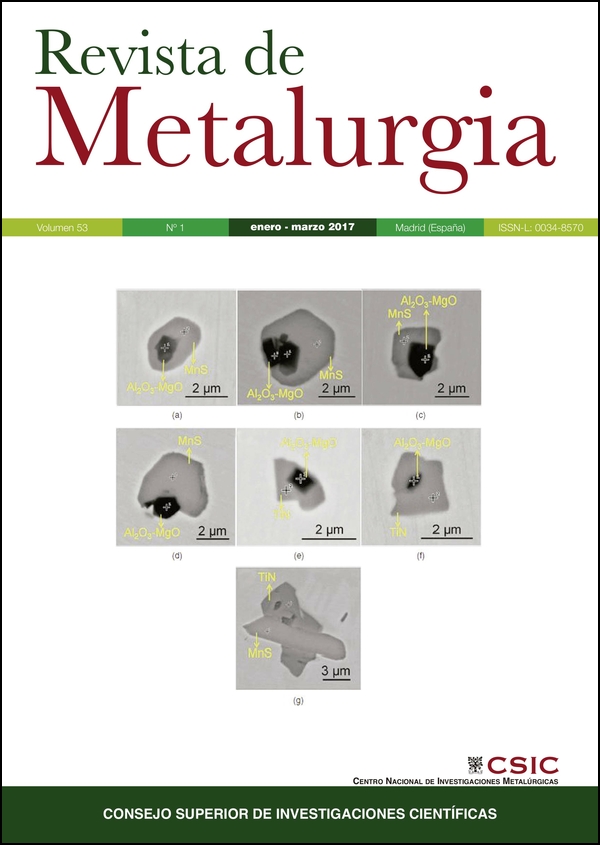Influences of argon gas shielding on diffusion bonding of Ti-6Al-4V alloy to aluminum
DOI:
https://doi.org/10.3989/revmetalm.088Keywords:
Argon gas shielding, Diffusion bonding, Dissimilar metal bonding, Solid-state bonding, Ti-6Al-4V alloyAbstract
This study presents a diffusion bonding process of commercially pure aluminum to Ti-6Al-4V alloy. Prepared samples were exposed to temperature of 560, 600 and 640 °C for the bonding time of 30, 45 and 60 min at the atmosphere of argon gas and non-argon. Diffusion bonding is a dissimilar metal welding process which can be applied to the materials without causing any physical deformations. The processed samples were also metallographically prepared, optically examined followed by Vickers microhardness test in order to determine joint strength. Scanning Electron Microscopy (SEM) and Energy Dispersive Spectroscopy (EDS) were used in this work to investigate the compositional changes in order to observe the influence of atmosphere shielding in the transition zone. The result of tests and analyses were tried to be compared with the effect of argon shielding. The significant influences have been observed in the argon shielding during diffusion bonding process.
Downloads
References
Akca, E., Gursel, A. (2016). Solid state welding and application in aeronautical industry. Periodicals of Engineering and Natural Sciences 4 (1), 1–8. https://doi.org/10.21533/pen.v4i1.46
Avery, R.E. (1991). Pay attention to dissimilar metal welds. American Institute of Chemical Engineers, pp. 1–7. https://nickelinstitute.org/~/Media/Files/TechnicalLiterature/GuidelinesforWeldingDissimilarMetals_14018_.pdf.
Aydın, K., Kaya, Y., Kahraman, N. (2012). Experimental study of diffusion welding/bonding of titanium to copper. Mater. Design 37, 356–368. https://doi.org/10.1016/j.matdes.2012.01.026
Barıs, B. (2007). Diffusion bonding of Ti-6Al-4V/304L steels couple using copper interlayer. Fırat University, Elazıg, Turkey.
Hoppin, G.S., Berry, T.F. (1970). Activated diffusion bonding. American Welding Society, New York, pp. 505–509.
Itharaju, R.R. (2004). Friction stir processing of aluminum alloys. Thesis, University of Kentucky, Kentucky, USA.
James, K.W. (2004). Handbook of Advanced Materials: Enabling New Designs. John Wiley & Sons, Inc., New Jersey, USA.
Kahraman, N., Gulenc, B., Findik, F. (2007). Corrosion and mechanical-microstructural aspects of dissimilar joints of Ti-6Al-4V and Al plates. Int. J. Impact Eng. 34 (8), 1423–1432. https://doi.org/10.1016/j.ijimpeng.2006.08.003
Kazakov, V.N. (1985). Diffusion bonding of materials. Perg. Press 8, 157–170.
Kicukov, E., Gursel, A. (2015). Ultrasonic welding of dissimilar materials: A review. Periodicals of Engineering and Natural Sciences 3 (1), 28–37. https://doi.org/10.21533/pen.v3i1.44
Krishnaiah, A., Chakkingal, U., Kim, H.S. (2008). Mechanical properties of commercially pure aluminum subjected to repetitive bending and straightening process. T. Indian I. Metals 61 (2), 165–167. https://doi.org/10.1007/s12666-008-0032-3
Leyens, C., Peters, M. (2003). Titanium and Titanium Alloys; Fundamentals and Applications. Wiley-VCH Verlag, Weinheim, Germany. https://doi.org/10.1002/3527602119
Luo, J.G., Acoff, V.L. (2000). Interfacial reactions of titanium and aluminum during diffusion welding. Welding Journal 79, 239–243.
Messler, R.W. (1999). Principles of Welding; Processes, Physics, Chemistry, and Metallurgy. John Wiley & Sons, Inc, Singapore. PMid:10427975
Nils, E.L. (1998). Influence of shielding gases on the quality of welds. 2nd International Symposium on Orbital Welding in High Purity Industries, France.
RMI, T. (2000). Titanium Alloy Guide. An RTI International Metals, New Jersey, USA.
Rusnaldy, R. (2001). Diffusion bonding: an advanced of material process. Rotasi 3, 23–27.
Sun, Z., Annergren, I., Pan, D., Mai, T. (2003). Effect of laser surface remelting on the corrosion behavior of commercially pure titanium sheet. Mat. Sci. Eng. A-Struct 345 (1-2), 293–300. https://doi.org/10.1016/S0921-5093(02)00477-X
Tsakiridis, P.E. (2012). Aluminium salt slag characterization and utilization – A review. J. Hazard. Mater. 217–218, 1–10. https://doi.org/10.1016/j.jhazmat.2012.03.052 PMid:22480708
Published
How to Cite
Issue
Section
License
Copyright (c) 2017 Consejo Superior de Investigaciones Científicas (CSIC)

This work is licensed under a Creative Commons Attribution 4.0 International License.
© CSIC. Manuscripts published in both the printed and online versions of this Journal are the property of Consejo Superior de Investigaciones Científicas, and quoting this source is a requirement for any partial or full reproduction.
All contents of this electronic edition, except where otherwise noted, are distributed under a “Creative Commons Attribution 4.0 International” (CC BY 4.0) License. You may read the basic information and the legal text of the license. The indication of the CC BY 4.0 License must be expressly stated in this way when necessary.
Self-archiving in repositories, personal webpages or similar, of any version other than the published by the Editor, is not allowed.
















